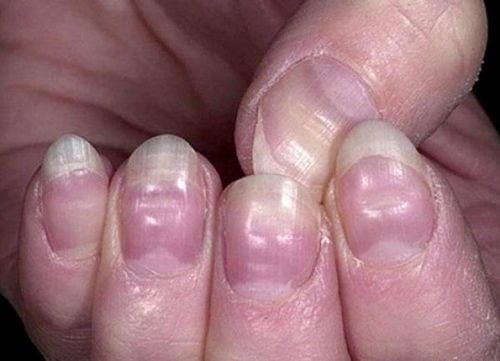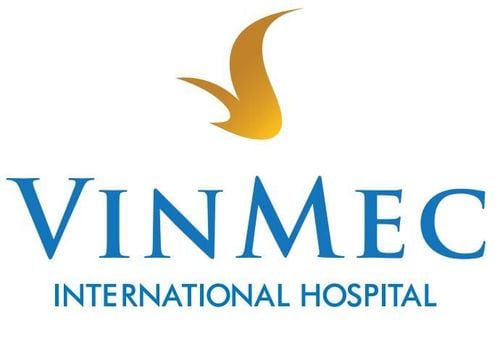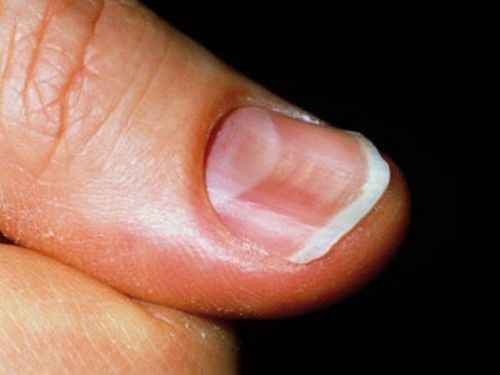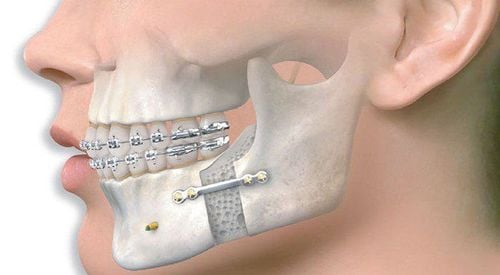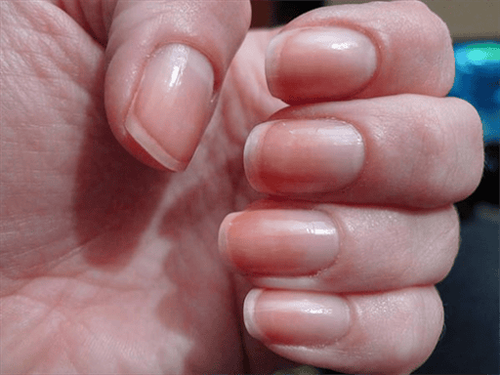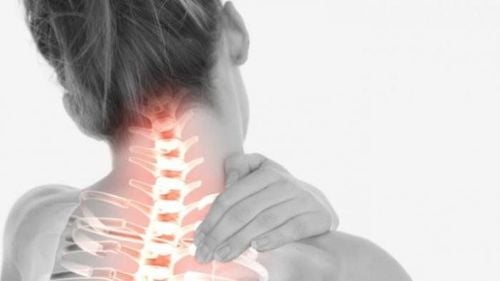This is an automatically translated article.
Abnormal changes in nail morphology can be considered as a basis to support the diagnosis of certain systemic or dermatological diseases. Nail diseases can be classified as localized nail disease, congenital or genetic defect, nail disease associated with systemic disease, or widespread skin disease.
1. Abnormalities of nail morphology
1.1. Abnormal nail morphology due to birth defects
Some of the abnormal nail deformities associated with birth defects include:
Some congenital ectodermal dysplasia: the person will have no nails (anonychia); Congenital thickening of the nail: manifesting as thickened, discolored, and transversely perforating nail beds (also known as ingrown nails); Nail-Patella syndrome: causes triangular nail deformity and partial disappearance of the thumb nail; Darier's disease: features abnormal nail morphology such as red or white streaks and a V-shaped wedge at the distal tip.
1.2. Abnormal nail deformity and dystrophy related to systemic problems
Nail morphological abnormalities due to systemic diseases include:
Plummer-Vinson syndrome (characterized by a spider-shaped esophagus due to possibly severe and untreated iron deficiency): causes about 50 % of patients with spoon-shaped nail abnormalities; Jaundice syndrome: is characterized by yellow, hard, excessively curved nails that penetrate the skin horizontally. This syndrome occurs in patients with lymphedema in the limbs or associated with chronic respiratory diseases; Deformity of half-nail nails (also known as Lindsay nails): common in patients with kidney failure, abnormal nails when the proximal half of the nail is white and the distal half of the nail is pink; White nail deformity: common in cirrhotic patients, sometimes the distal third of the nail is normal pink; Beau's line: is a morphological abnormality of the nail, showing transverse grooves in the nail plate, which occurs when the nail growth is temporarily delayed. Some of the triggers are infection, trauma, or systemic illness; Nail detachment: is the result when the nail plate stops growing temporarily, but the thickness of the nail is still guaranteed, thus causing separation of the proximal nail plate from the nail bed. This usually occurs a few months after hand, foot and mouth disease or from certain viral infections.
1.3. Nail abnormalities associated with dermatological conditions
Nail deformities associated with common dermatological diseases:
People with psoriasis may develop a number of nail changes, including: irregular pitting, oil drops, nail cups, nail thickening and crumbling nail; Lichen planus: can leave scars with high longitudinal margins and division of the nail that favors the formation of an irregular triangular nail or total loss of the nail;
1.4. Unusual nail discoloration
Some abnormalities of nail morphology in color can be caused by some of the following reasons:
Use of cancer drugs (of which the most common are taxanes): can blacken nails, spot patches on nails spreading or spreading horizontally; Quinacrine: Unusual nails that are yellow-green or white when exposed to ultraviolet light; Cyclophosphamide: The distal margin of the nail changes to dark gray or light blue; Arsenic: Deformity of nails to diffuse light brown; Tetracyclines, ketoconazole, phenothiazines, sulfonamides and phenindione: Unusual brown or blue nails; Silver salts (argyria): can cause nails to turn bluish-gray; Smoking or nail polish: can cause fingernails and fingertips to turn yellow or light brown;
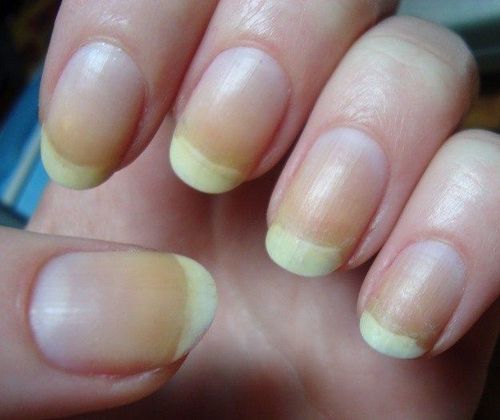
Bất thường hình thái móng tay về màu sắc
1.5. Central nail dystrophy
Central nail dystrophy has unusual nail features: longitudinally elongated small fissures, arranged similar to the branches of an evergreen tree.
The cause of central nail dystrophy is often unknown, but traumatic factors may play an important role. In addition, the habit of using technical equipment often causes the nails to repeat the same operation that can increase the risk of this nail abnormality.
1.6. Unusual black stripe nails
Abnormal nail morphology with black stripes, essentially longitudinal bands of hyperpigmentation, extending from the proximal nail fold and cuticle to the end of the free margin of the nail. In people with dark skin, these black stripes may be a physiological nail deformity and do not require treatment.
Other causes of black striped nails include:
Trauma; Pregnant; Addison's disease ; Post-inflammatory nail hyperpigmentation; Using certain medications such as doxorubicin, 5-fluorouracil, zidovudine, and psoralens; Melanoma (malignant cancer).
1.7. Unusual nail horn
Abnormal nail morphology followed by the nail horns or nail dystrophy. In this type of abnormality, the nail is thicker and more curved, mainly in the thumb. Nail horns are more common in the elderly. Treatment is also simple when just trimming the deformed part of the nail.
1.8. Nail cup
Nail cup is a type of nail deformity when the nail plate completely separates from the nail bed or completely dissolves the nail plate. This condition, considered a systemic reaction, is common in patients treated with tetracyclines, doxorubicin, 5-fluorouracil, cloxacillin, cephaloridine, trimethoprim/sulfamethoxazole, diflunisal, etretinate, indomethacin, isoniazid, griseofulvin, and isotretinoin.
Partial nail separation can occur when the patient is exposed to many irritants, contact dermatitis, psoriasis, thyrotoxicosis or Candida albicans infection.
1.9. Unusual nails created by yourself
This type of nail morphological abnormality occurs because the patient frequently pokes and punches the nail, thereby creating parallel horizontal grooves or margins. In addition, subungual haemorrhage is also a form of onycho till romania.
1.10. Claw
Ingrown toenail is a deformity of the nail when the nail plate bends excessively horizontally. Ingrown toenails are common in people with psoriasis, SLE, Kawasaki, cancer, end-stage renal failure and some other genetic syndromes. Patients often complain of pain at the edge of the nail, where the nail plate bends and touches the tip of the finger.
1.11. Subungual hematoma - abnormal nail bed trauma
Subungual hematoma is an abnormal nail form that occurs when blood collects between the nail plate and the nail bed following an injury. This condition causes pain in the patient, the nail turns blue-black, and eventually the nail plate separates and is temporarily lost. In case of trauma causing strong pressure can affect, damage the nail bed, that area the nail deformity can be permanent.
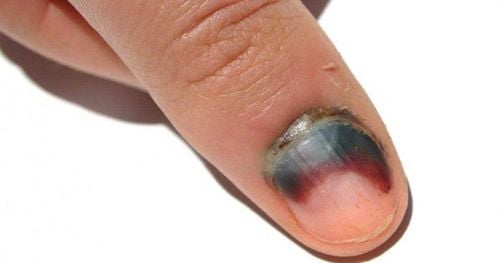
Tụ máu dưới móng là một dạng móng tay bất thường
1.12. Trachyonychia (unusual nails like sandpaper)
Trachyonychia is the word for rough and opaque nails, which occurs in people with alopecia areata, lichen planus, atopic dermatitis, and psoriasis.
1.13. Abnormal nail due to tumor
Some unusual nail deformities can be benign or cancerous tumors.
Benign tumors include:
Mucinous cysts; Tumor infection; U glomus. Malignant tumors include;
Bowen's disease; Squamous cell carcinoma; Melanoma (malignant cancer).
2. Treatment and prognosis of nail morphological abnormalities
Nail abnormality interventions may include:
Debris removal and correction of nail shape; Avoid exposing your nails to irritants; In the case of fungal infections and peritonitis caused by Candida, antifungal drugs may be indicated; Congenital or hereditary nail deformities often have no specific treatment; Nail dystrophies can use triamcinolone acetonide injected into the nail base every 2 - 4 weeks but often cause much pain; In case it is necessary to remove the dystrophic nail, the patient may not need surgery but use a compound of Urea 40%, Lanolin 20%, White Wax 5%, White Petrolatum 25% and Silica gel. Abnormal changes in nail morphology can be considered as a basis to support the diagnosis of certain systemic or dermatological diseases. Therefore, when there are abnormal signs, you should go to medical facilities for examination and treatment.
Please dial HOTLINE for more information or register for an appointment HERE. Download MyVinmec app to make appointments faster and to manage your bookings easily.




